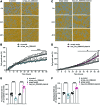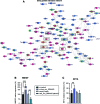Circular RNA hsa_circ_0084443 Is Upregulated in Diabetic Foot Ulcer and Modulates Keratinocyte Migration and Proliferation
- PMID: 32117579
- PMCID: PMC7047102
- DOI: 10.1089/wound.2019.0956
Circular RNA hsa_circ_0084443 Is Upregulated in Diabetic Foot Ulcer and Modulates Keratinocyte Migration and Proliferation
Abstract
Objective: Insufficient knowledge about the molecular pathology of diabetic foot ulcer (DFU) impedes the development of effective wound treatment. Circular RNAs (circRNAs) are a novel class of RNA recently discovered to be widely expressed and have important biological functions; however, their role in skin wound healing remains largely unexplored. In this study, we investigated the role of circRNAs in DFU. Approach: CircRNA expression was profiled in normal wounds (NWs) and DFUs by microarray analysis, and hsa_circ_0084443 was identified as differentially expressed. The circularity and subcellular localization of hsa_circ_0084443 were characterized by northern blotting, real-time PCR, and fluorescence in situ hybridization. Cell migration, cell growth, and the transcriptome of human primary keratinocytes were analyzed after overexpression or RNA interference of hsa_circ_0084443. Results: hsa_circ_0084443 is downregulated in NWs compared with intact skin, and its level is higher in DFUs than NWs. We confirmed its circularity and presence in the cytoplasm of human epidermal keratinocytes. We showed that hsa_circ_0084443 reduced motility while enhancing the growth of keratinocytes. Furthermore, we identified a gene network with the potential to mediate the biological effect of hsa_circ_0084443. Innovation: CircRNAs have a functional role and a potential clinical significance in skin wound healing. Conclusions: We identified hsa_circ_0084443, a circRNA downregulated during NW healing, as a negative regulator of keratinocyte migration. Higher levels of hsa_circ_0084443 were detected in DFU samples, suggesting that it plays a role in pathology. These findings pave the way to understanding the functional role of circRNAs in human skin wound healing.
Keywords: circular RNA; diabetic foot ulcer; keratinocyte; noncoding RNA; wound healing.
Copyright © 2020 by Mary Ann Liebert, Inc., publishers.
Conflict of interest statement
No competing financial interests exist. The content of this article was expressly written by the authors listed. No ghostwriters were used to write this article.
Figures








Similar articles
-
Upregulation of circ_0080968 in diabetic foot ulcer inhibits wound healing via repressing the migration and promoting proliferation of keratinocytes.Gene. 2023 Oct 20;883:147669. doi: 10.1016/j.gene.2023.147669. Epub 2023 Jul 25. Gene. 2023. PMID: 37500023
-
Serum and exosomal hsa_circ_0000907 and hsa_circ_0057362 as novel biomarkers in the early diagnosis of diabetic foot ulcer.Eur Rev Med Pharmacol Sci. 2020 Aug;24(15):8117-8126. doi: 10.26355/eurrev_202008_22498. Eur Rev Med Pharmacol Sci. 2020. PMID: 32767340
-
Silencing circular RNA hsa_circ_0004491 promotes metastasis of oral squamous cell carcinoma.Life Sci. 2019 Dec 15;239:116883. doi: 10.1016/j.lfs.2019.116883. Epub 2019 Oct 25. Life Sci. 2019. PMID: 31669576
-
Function of circular RNAs in the pathogenesis of colorectal cancer.Biomed Pharmacother. 2021 Aug;140:111721. doi: 10.1016/j.biopha.2021.111721. Epub 2021 May 17. Biomed Pharmacother. 2021. PMID: 34015582 Review.
-
Emerging role of circular RNAs in the pathobiology of lung cancer.Biomed Pharmacother. 2021 Sep;141:111805. doi: 10.1016/j.biopha.2021.111805. Epub 2021 Jun 11. Biomed Pharmacother. 2021. PMID: 34120067 Review.
Cited by
-
Non-coding RNAs: Role in diabetic foot and wound healing.World J Diabetes. 2022 Dec 15;13(12):1001-1013. doi: 10.4239/wjd.v13.i12.1001. World J Diabetes. 2022. PMID: 36578864 Free PMC article. Review.
-
miR-155 promotes m6A modification of SOX2 mRNA through targeted regulation of HIF-1α and delays wound healing in diabetic foot ulcer in vitro models.J Diabetes Investig. 2025 Jan;16(1):60-71. doi: 10.1111/jdi.14327. Epub 2024 Nov 7. J Diabetes Investig. 2025. PMID: 39509294 Free PMC article.
-
Progress of microneedle targeted modulation technology in the reconstruction of immune microenvironment in diabetic wounds.Eur J Med Res. 2025 May 20;30(1):405. doi: 10.1186/s40001-025-02667-4. Eur J Med Res. 2025. PMID: 40394697 Free PMC article. Review.
-
Cell migration in diabetic wound healing: Molecular mechanisms and therapeutic strategies (Review).Int J Mol Med. 2025 Aug;56(2):126. doi: 10.3892/ijmm.2025.5567. Epub 2025 Jun 20. Int J Mol Med. 2025. PMID: 40539458 Free PMC article. Review.
-
MSC-derived exosomal circMYO9B accelerates diabetic wound healing by promoting angiogenesis through the hnRNPU/CBL/KDM1A/VEGFA axis.Commun Biol. 2024 Dec 26;7(1):1700. doi: 10.1038/s42003-024-07367-z. Commun Biol. 2024. PMID: 39725699 Free PMC article.
References
-
- World Health Organization. Global Report on Diabetes. Geneva, Switzerland: World Health Organization, 2016;978:88
-
- Frykberg RG, Zgonis T, Armstrong DG, et al. . Diabetic foot disorders. A clinical practice guideline (2006 revision). J Foot Ankle Surg 2006;45:S1–S66 - PubMed
-
- Baltzis D, Eleftheriadou I, Veves A. Pathogenesis and treatment of impaired wound healing in diabetes mellitus: new insights. Adv Ther 2014;31:817–836 - PubMed
-
- Catrina SB, Zheng X. Disturbed hypoxic responses as a pathogenic mechanism of diabetic foot ulcers. Diabetes Metab Res Rev 2016;32:179–185 - PubMed
Publication types
MeSH terms
Substances
LinkOut - more resources
Full Text Sources
Other Literature Sources
Medical
Molecular Biology Databases

